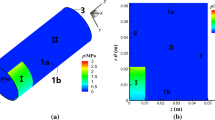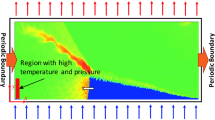Abstract
The work presents results of the modeling of a three-dimensional rotation detonation engine combustion chamber; the chamber is supplied with a hydrogen–oxygen mixture. The chamber cross-section shape is annular. To model the processes in the chamber, a computer program was created incorporating a mathematical model for multi-component gas dynamics with chemical transformations, turbulence, and external energy sources. An elementary chemical kinetic mechanism and a high-order accuracy numerical model were used. Different modes of fuel and oxidizer supply, and three types of the combustible mixture: rich, lean, and stoichiometric, were investigated. Cases for additional air or oxygen supply from orifices at the lateral walls were studied. Several modes of stable detonation, single wave or multiple waves, were obtained, for a stoichiometric mixture with additional oxygen supply, for a rich mixture with additional oxygen, and for a lean mixture with additional air. For those cases, the fuel and oxidizer fluxes and the thrust characteristics were analyzed.



















Similar content being viewed by others
References
Wolanski, P.: Detonative propulsion. Proc. Combust. Inst. 34(1), 125–158 (2013). https://doi.org/10.1016/j.proci.2012.10.005
Zeldovich, Y.B.: On the use of detonative combustion in power engineering. J. Tech. Phys. 10, 1453–1461 (1940). (in Russian)
Nicholls, J.A., Wilkinson, H.R., Morrison, R.B.: Intermittent detonation as a thrust producing mechanism. J. Jet Propul. 27(5), 534–541 (1957). https://doi.org/10.2514/8.12851
B. V. Voitsekhovskii, Steady detonation, Dokl. Akad. Nauk SSSR, 129, 6, 1254–1256 (1959). (In Russian)
Voitsekhovskii, B.V., Mitrofanov, V.V., Topchiyan, M.E.: Detonation-Front Structure in Gases. Izd. Sib. Otd. Akad. Nauk SSSR, Novosibirsk (1963). (in Russian)
V. Anand, E. Gutmark, Rotating detonation combustors and their similarities to rocket instabilities, Progress in Energy and Combustion Science, 73, 182–234 (2019). https://doi.org/10.1016/j.pecs.2019.04.001
Bykovskii, F.A., Zhdan, S.A., Vedernikov, E.F.: Continuous spin deto-nation in annular combustors. Combustion, Explosion, and Shock Waves 41(4), 449–459 (2005). https://doi.org/10.1007/s10573-005-0055-6
Kindracki, J., Kobiera, A., Wolanski, P., Gut, Z., Folusiak, M., Swiderski, K.: Experimental and numerical study of the rotating detonation engine in hydrogen-air mixtures. Prog. Propuls. Phys. 2(555–582), 555 (2012)
Frolov, S.M., Dubrovskii, A.V., Ivanov, V.S.: Three-dimensional numerical simulation of operation process in rotating detonation engine. Progress in Propulsion Physics 4, 467–488 (2013). https://doi.org/10.1051/eucass/201304467
Z. Pana, B. Fana, X. Zhanga, M. Guia, G. Donga, Wavelet pattern and self-sustained mechanism of gaseous detonation rotating in a coaxial cylinder, Combustion and Flame, 158(11), 2220–2228 (2011). https://doi.org/10.1016/j.combustflame.2011.03.016
St. George, A., Driscoll, R., Anand, V., Gutmark, E.: On the existence and multiplicity of rotating detonations. Proc. Combust. Inst. 36, 2691–2698 (2017). https://doi.org/10.1016/j.proci.2016.06.132
Tang, X.-M., Wang, J.-P., Shao, Y.-T.: Three-dimensional numerical investigations of the rotating detonation engine with a hollow combustor. Combust. Flame 162, 997–1008 (2015). https://doi.org/10.1016/j.combustflame.2014.09.023
Sun, J., Zhou, J., Liu, S., Lin, Z., Lin, W.: Numerical investigation of a non-premixed hollow rotating detonation engine. Int. J. Hydrog. Energy 44, 17084–17094 (2019). https://doi.org/10.1016/j.ijhydene.2019.04.168
Bykovskii, F.A., Mitrofanov, V.V., Vedernikov, E.F.: Continuous detonation combustion of fuel-air mixtures. Combust. Explos. Shock Waves 33, 344–353 (1997). https://doi.org/10.1007/BF02671875
Bykovskii, F.A., Vedernikov, E.F., Zholobov, Y.A.: Detonation combustion of lignite with titanium dioxide and water additives in air. Combust. Explos. Shock Waves 53, 453–460 (2017). https://doi.org/10.1134/S0010508217040098
Nakagami, S., Matsuoka, K., Kasahara, J., Kumazawa, Y., Fujii, J., Matsuo, A.: Experimental visualization of the structure of rotating detonation waves in a disk-shaped combustor. J. Propuls. Power 33, 80–88 (2016). https://doi.org/10.2514/1.B36084
Wen, H., Xie, Q., Wang, B.: Propagation behaviors of rotating detonation in an obround combustor. Combust. Flame 210, 389–398 (2019). https://doi.org/10.1016/j.combustflame.2019.09.008
Zhou, R., Wang, J.-P.: Numerical investigation of shock wave reflections near the head ends of rotating detonation engines. Shock Waves 23, 461–472 (2013). https://doi.org/10.1007/s00193-013-0440-0
Bykovskii, F.A., Zhdan, S.A., Vedernikov, E.F.: Continuous spin detonation of a hydrogen-air mixture with addition of air into the products and the mixing region. Combust. Explos. Shock Waves 46(1), 52–59 (2010). https://doi.org/10.1007/s10573-010-0009-5
Bykovskii, F.A., Zhdan, S.A.: Current status of research of continuous detonation in fuel-air mixtures. Combust. Explos. Shock Waves 51(1), 21–35 (2015). https://doi.org/10.1134/S0010508215010025
Sato, T., Raman, V.: Detonation structure in ethylene/air-based non-premixed rotating detonation engine. J. Propul. Power 36(5), 752–762 (2020). https://doi.org/10.2514/1.B37664
Sato, T., Chacon, F., White, L., Raman, V., Gamba, M.: Mixing and detonation structure in a rotating detonation engine with an axial air inlet. Proc. Combust. Inst. 38(3), 3769–3776 (2020). https://doi.org/10.1016/j.proci.2020.06.283
Cocks, P.A.T., Holley, A.T., Rankin, B.A.: High fidelity simulations of a non-premixed rotating detonation engine. 54th AIAA Aerospace Sciences Meeting, San Diego, CA, USA 2016-0125 (2016). https://doi.org/10.2514/6.2016-0125
CHEMKIN. A software package for the analysis of gas-phase chemical and plasma kinetics. CHE-036-1. Chemkin collection release 3.6. Reaction Design, September (2000)
Wilcox, D.C.: Turbulence Modeling for CFD. DCW Industries, La Canada (1994)
Kader, B.A.: Temperature and concentration profiles in fully turbulent boundary layers. Int. J. Heat Mass Transf. 24, 1541–1544 (1981). https://doi.org/10.1016/0017-9310(81)90220-9
Launder, B.E., Spalding, D.B.: The numerical computation of turbulent flows. Comput. Methods Appl. Mech. Eng. 3, 269–289 (1974). https://doi.org/10.1016/0045-7825(74)90029-2
Bredberg, J.: On the Wall Boundary Condition for Turbulence Models. Internal report 00/4. Department of Thermo and Fluid Dynamics Chalmers University Of Technology, Goteborg, Sweden
Popovac, M., Hanjalic, K.: Compound wall treatment for RANS computation of complex turbulent flows and heat transfer. Flow Turbul. Combust. 78, 177–202 (2007). https://doi.org/10.1007/s10494-006-9067-x
Smirnov, N.N., Nikitin, V.F., Stamov, L.I., Mikhalchenko, E.V., Tyurenkova, V.V.: Three-dimensional modeling of rotating detonation in a ramjet engine. Acta Astronaut. 163((A)), 168–176 (2019). https://doi.org/10.1016/j.actaastro.2019.02.016
Maas, U., Warnatz, J.: Ignition process in hydrogen-oxygen mixtures. Combust. Flame 74(1), 53–69 (1988). https://doi.org/10.1016/0010-2180(88)90086-7
Heghes, C.I.: C1–C4 hydrocarbon oxidation mechanism. Rupertus Carola University of Heidelberg, Dissertation for the degree of Doctor of Natural Sciences, Germany (2006)
Hong, Z.: An improved hydrogen/oxygen mechanism based on shock tube/laser absorption measurements. Stanford University, Dissertation for the degree of Doctor of Philosophy, USA (2010)
Smirnov, N.N., Penyazkov, O.G., Sevrouk, K.L., Nikitin, V.F., Stamov, L.I., Tyurenkova, V.V.: Nonequilibrium processes in meta-stable media. Eur. Phys. J. E 41(5), 66 (2018). https://doi.org/10.1140/epje/i2018-11672-1
Smirnov, N.N., Penyazkov, O.G., Sevrouk, K.L., Nikitin, V.F., Stamov, L.I., Tyurenkova, V.V.: Onset of detonation in hydrogen-air mixtures due to shock wave reflection inside a combustion chamber. Acta Astronaut. 149, 77–92 (2018). https://doi.org/10.1016/j.actaastro.2018.05.024
Acknowledgements
This work was supported by the subsidy given to the Federal Science Center Scientific Research Institute for System Analysis of the Russian Academy of Sciences to implement the state assignment on the topic No. FNEF-2021-0021 “Development of algorithms and codes for multiscale processes and combustion simulations”.
Author information
Authors and Affiliations
Additional information
Communicated by E. Gutmark.
Publisher's Note
Springer Nature remains neutral with regard to jurisdictional claims in published maps and institutional affiliations.
Rights and permissions
About this article
Cite this article
Mikhalchenko, E.V., Nikitin, V.F., Phylippov, Y.G. et al. Numerical study of rotating detonation onset in engines. Shock Waves 31, 763–776 (2021). https://doi.org/10.1007/s00193-021-01051-5
Received:
Revised:
Accepted:
Published:
Issue Date:
DOI: https://doi.org/10.1007/s00193-021-01051-5




